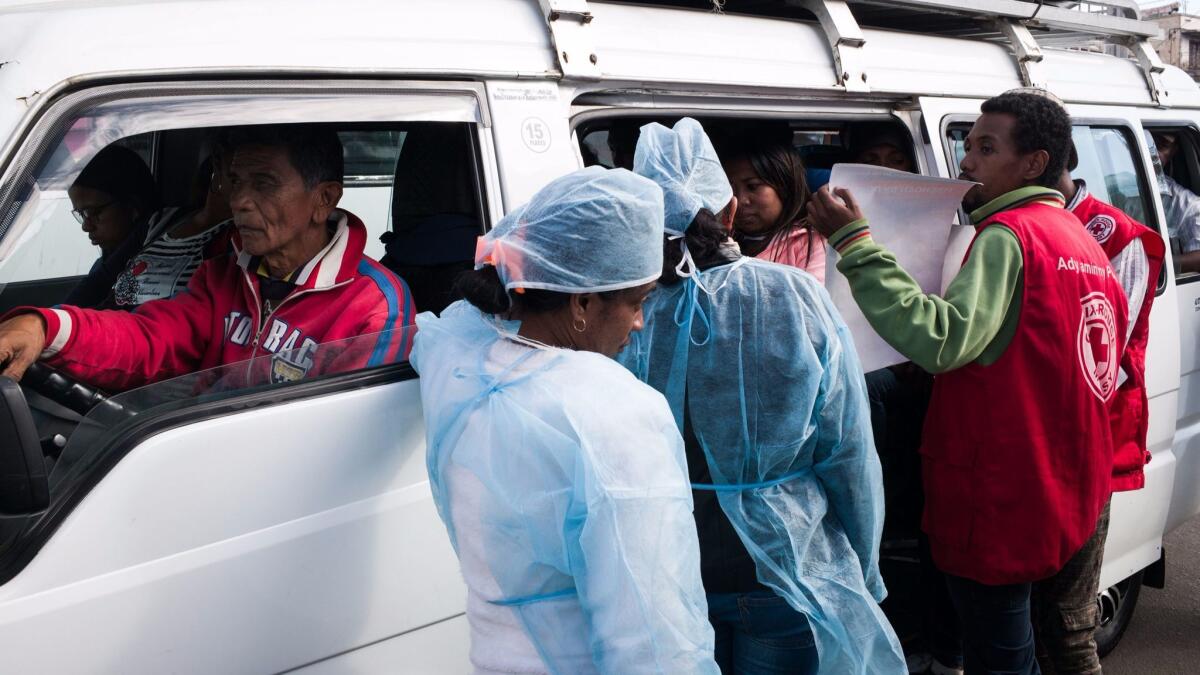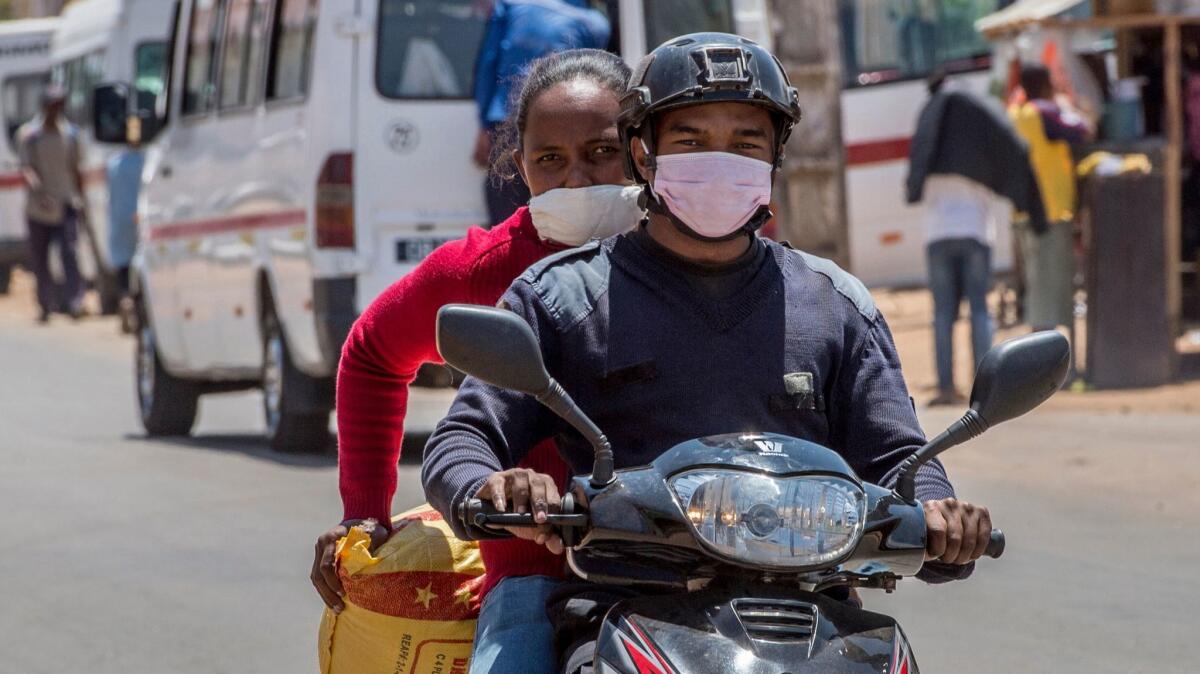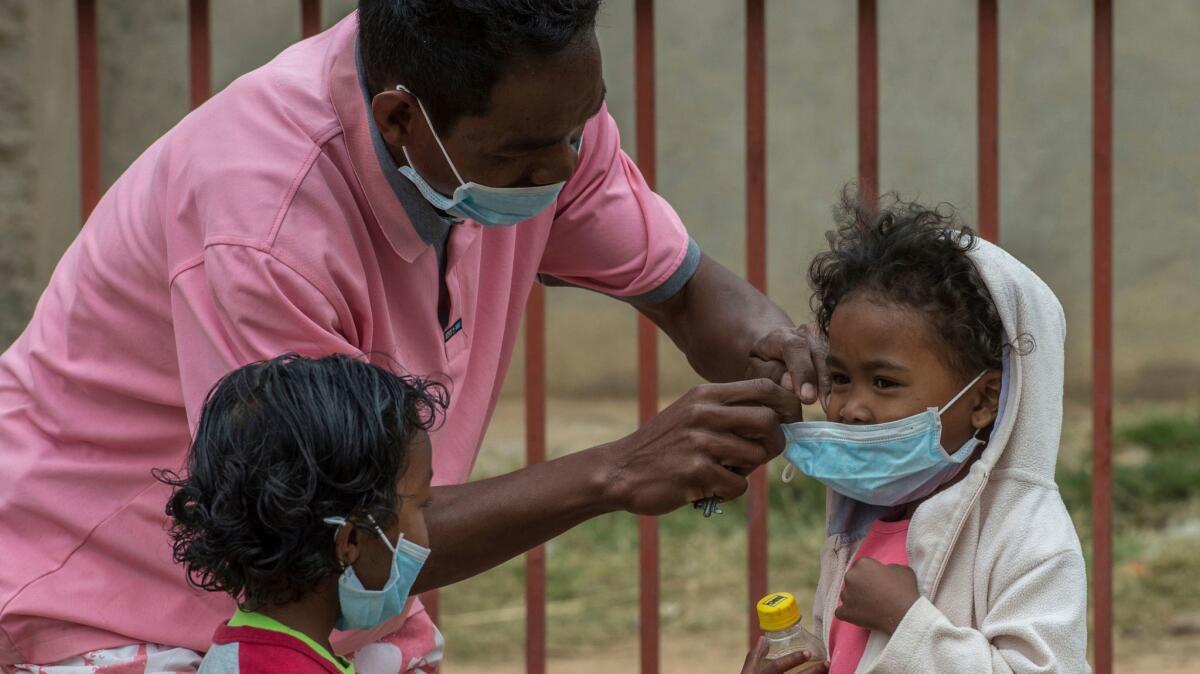Q&A: The Black Death is killing people: Why is Madagascar facing its worst plague outbreak in years?

Instead of cases in the hinterlands where plague is endemic, the disease — which is initially spread by flea bites and was known as the Black Death in medieval times — has spread to the capital, Antananarivo, and other densely populated cities for t
- Share via
Madagascar sees cases of plague nearly every year in the rainy season.
This year is different. Instead of cases in the hinterlands where plague is endemic, the disease — which is initially spread by flea bites and was known as the Black Death in medieval times — has spread to the capital, Antananarivo, and other densely populated cities for the first time, killing 45 people and sparking panic.
By Monday, 387 cases had been reported, including 167 in the densely populated capital.
The biggest problem for authorities trying to control the outbreak is that it took two weeks after the first case to detect it, and that most cases — 277 so far — have been a particularly virulent form of the disease.
Madagascar, an island off Africa’s east coast, is the country most seriously affected by plague, but others, including the United States, Russia, China, Peru, Bolivia and several African nations, regularly report cases.

How did the disease spread so fast?
In late August, a 31-year-old man traveled from his home in Toamasina, a town on Madagascar’s east coast, to the central highlands town of Ankazobe, in a region where plague is endemic. When he came down with fever, a headache and fatigue, he probably assumed he had malaria, a common illness throughout Africa.
But plague has many of the same symptoms. Bubonic plague is easily treated with antibiotics, but if untreated it can reach the lungs, developing into pneumonic plague, which can kill a patient within 24 hours.
Pneumonic plague, the version that is spreading rapidly in Madagascar, is more virulent and dangerous than bubonic plague, because it is swiftly spread through infected droplets coughed into the air.
Four days after he became ill, the man boarded a bush taxi, or commuter minibus, and made the journey home, passing through the capital. On the way, he developed respiratory symptoms, indicating the disease had spread to his lungs. He died shortly after he reached home.
His body was prepared for burial at the nearest hospital in Moramanga district, which, like Toamasina, does not ordinarily see cases of plague, so the staff took no precautions to prevent infection.
The sick man came into contact with dozens of people, at least 31 people of whom fell ill, four of whom died.
Let’s be realistic. We are defeated by the plague. You can leave your house today and catch the plague tomorrow.
— Elysee Ratsiraka, mayor of Toamasina, Madagascar
Authorities didn’t realize they were dealing with the more virulent form of plague until Sept. 11, when a 47-year-old woman with pneumonic plague died in a hospital in Antananarivo.
The delay was disastrous.
In recent days, the disease has spread more quickly. On Oct. 5, there were 258 cases, according to the Health Ministry. By Monday the number was 387, including 312 in Antananarivo and Toamasina.
By late last month, cases of pneumonic plague were popping up in 20 districts across the country, including the far north and the west coast. Authorities fear the disease will continue to spread.

How dangerous is the plague outbreak?
Plague season in Madagascar is just getting started and hundreds have already fallen ill, posing the threat that the number of deaths this year could far surpass last year’s total of 52.
The season of plague in Madagascar usually runs from September to April — spring to fall in the Southern Hemisphere. Health authorities are concerned the disease could spread further, with cases of pneumonic plague already being reported around the country.
Plague is dangerous if left untreated. The disease is spread by a bacteria, Yersinia pestis, and initially spread by fleas carried by rats, prairie dogs and other small mammals.
“Plague is a disease of poverty. It thrives in places with poor sanitary conditions and inadequate health services. It can kill quickly if left untreated, but can also be cured by antibiotics if delivered early,” the World Health Organization said in a statement.
In Madagascar’s capital, the wards in the main hospital are full and two tents have been erected on the grounds to treat patients, according to local media.
The outbreak has caused panic, with reports of people buying antibiotics from drugstores, unaware whether they were getting the correct drug.
The parents of one small boy suspected of having pneumonic plague took him from the hospital and fled, posing a risk to his life, themselves and any other people he might come in contact with, Dr. Manitra Rakotoarivony told local media.
At least two participants in an international basketball competition in Antananarivo last week contracted the illness, including a South African sports official who tested positive Tuesday and a Seychellois coach who died late last month.
The WHO fears other participants may have contracted the disease, and all participants are being monitored to prevent the spread of the disease overseas.

What is being done to stop the plague from spreading?
In Antananarivo, the government has temporarily closed universities and schools for disinfection and has banned public gatherings to try to prevent the disease from spreading further.
People are buying masks to protect themselves and authorities have warned members of the public to seek swift treatment if they experience flu-like symptoms.
District and neighborhood leaders have been warned to keep track of people entering their areas and ensure that cases of plague are reported.
But Madagascar’s poorly equipped health system is one of the many challenges in overcoming the spread of the disease. In local health centers, staff lack basic protective garments to guard against infection.
The country is impoverished, with many people unable to afford basic expenses such as transportation. People often tend to self-medicate, buying cheap medicines at shops, rather than going to a hospital or clinic.
The mayor of Toamasina, Elysee Ratsiraka, said last week that the outbreak had overwhelmed the state and called on the government to seek more international help.
“Let’s be pragmatic. Let’s be realistic. We are defeated by the plague. You can leave your house today and catch the plague tomorrow,” Ratsiraka said.
The WHO has delivered 1.2 million doses of antibiotics and will spend $1.5 million to control the spread of the disease.
How widely could the plague spread?
According to the WHO, the risk that the plague will spread throughout Madagascar is high.
“Pneumonic plague is a form of plague that is transmissible from person to person, with a potential to trigger severe epidemics if inadequately controlled,” the organization said in a statement.
It said there was also a moderate risk the disease could spread to other countries in Africa, because there are frequent flights to nearby countries and Indian Ocean islands.
But according to the WHO, the danger of the plague spreading around the globe is low.
This story was reported with a grant from the United Nations Foundation.
ALSO
Twitter: @RobynDixon_LAT
Sign up for Essential California
The most important California stories and recommendations in your inbox every morning.
You may occasionally receive promotional content from the Los Angeles Times.







